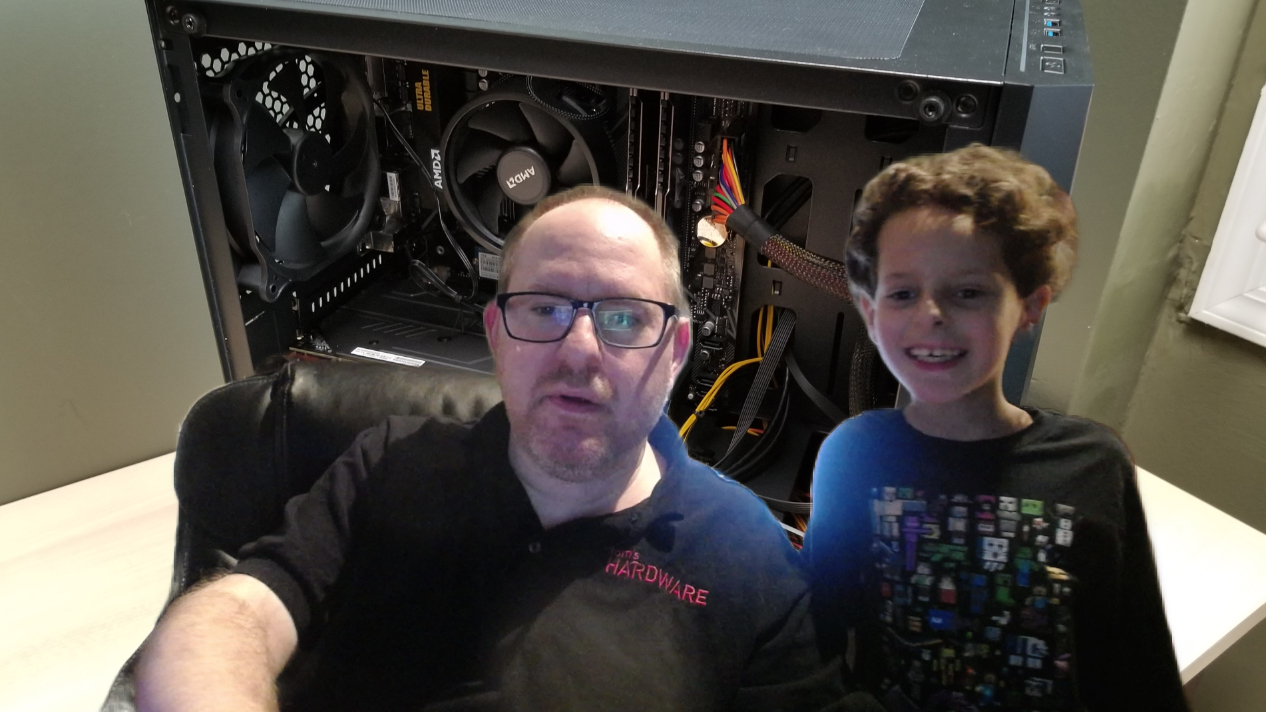Nvidia Broadcast Tested: No More Embarrassing Noises
Removes unwanted background noise, clutter from your video calls and streams.
If you're dialing into a meeting for work or broadcasting a live game stream to Twitch (see how to stream from a PC with Twitch), background noise and images from your home can be embarrassing. Just imagine being on a call with your boss when your child starts throwing a temper tantrum in the next room. How about recording a podcast with your air conditioning blowing next to you, or chatting with a new client and hoping that they don't notice the piles of dirty laundry behind you?
Enter Nvidia Broadcast, a free app that lets anyone with an RTX graphics card, perhaps one of the best graphics cards, filter out unwanted noise and blur or replace the background on their videos. I had a chance to test Nvidia Broadcast, subjecting it to noises ranging from a loud, clicky keyboard to a screaming child and I came away impressed with its ability to remove unwanted noises. It also did a really good job of green screening.
Nvidia Broadcast Requirements
In order to install Nvidia Broadcast, you'll need any RTX card, along with driver version R455 or higher. During testing, I used driver version 456 with an RTX 2070 Super.
UI and Features of Nvidia Broadcast
Nvidia Broadcast is a very simple app that runs in the background at all times and shows up as a device in any software that lets you choose audio or video inputs. So no matter what software you're using to stream or make a video call, including your web browser, you're covered.
The UI for Broadcast is very straightforward and shows you its limited, but powerful feature set. There are three tabs:
- Microphone: Allows you to choose which microphone you'll be filtering, enable noise removal and adjust the strength of the noise removal. You can also record audio here to test the noise removal directly.
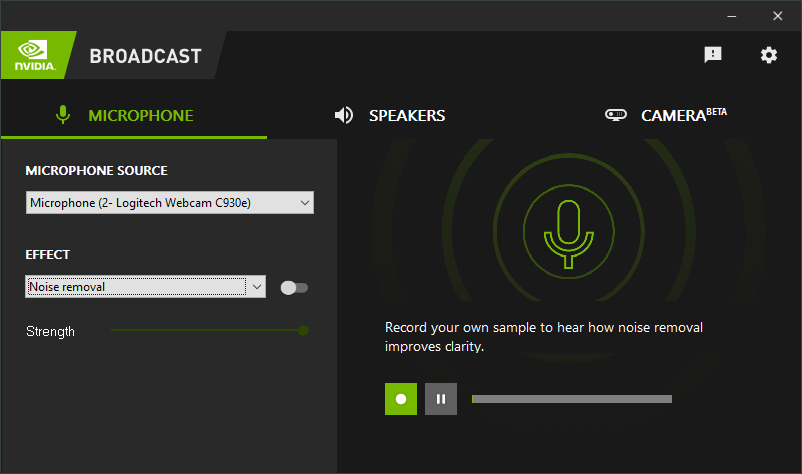
- Speakers: Allows you to enable noise removal for incoming audio so if someone on your call has background noise, you can avoid hearing it. There are several sound samples here you can test with, including rain, crunching chips and typing.
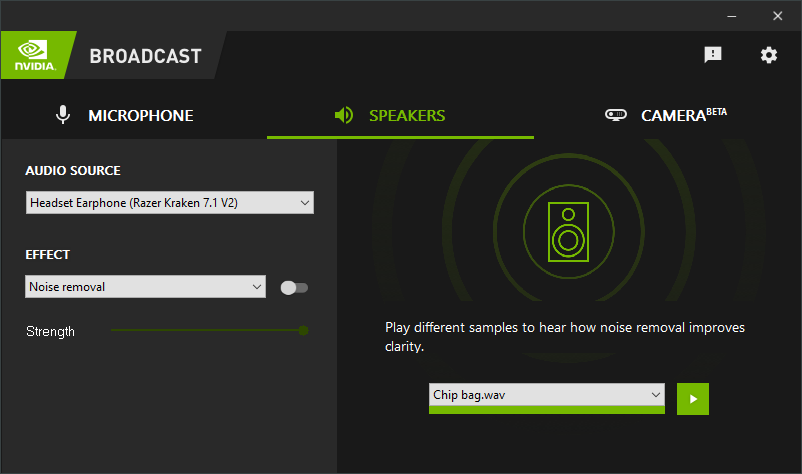
- Camera: Lets you choose the camera device and then choose Background Blur (an adjustable bokeh effect), Background Replacement (put a photo or video behind you) or Background Removal (silhouette yourself, great for appearing on top of games). You can also choose Auto frame, which crops the camera image to follow your head, but if you select that option, you can't use any of the background modifications.
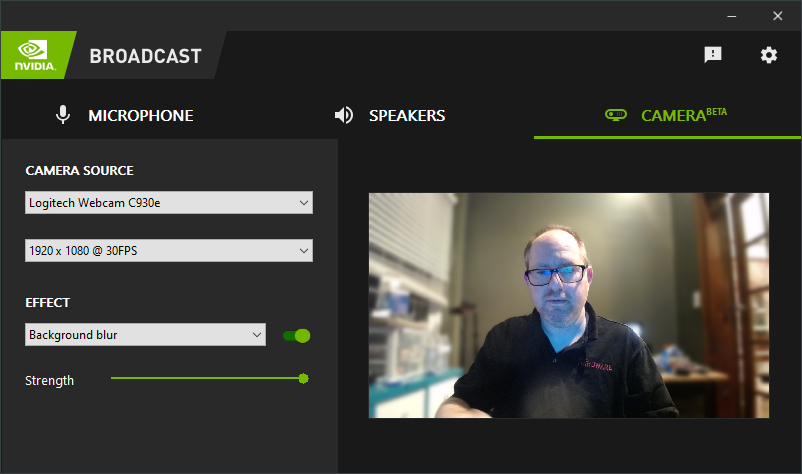
Noise Removal in Nvidia Broadcast
When Nvidia first demoed Broadcast by showing an employee filtering out a hair dryer, I thought "it can't really be as effective as they claim." But, after a few hours of testing with different background noises, I'm a believer.
Get Tom's Hardware's best news and in-depth reviews, straight to your inbox.
When I tried pounding away on my very-clicky Patriot Viper V765, one of the best gaming keyboards, with noise removal on, the sound of the clicks disappeared like magic. It wasn't quieter; it was just gone.
It worked equally well with fan noise from my air conditioner. I turned the fan up to the max and tried it out.
But filtering for a high-pitched, mechanical noise seems pretty simple. How about filtering out a child's temper tantrum? I got my eight year old to fake throwing a fit right behind me and, once I enabled noise removal, every whine of "I'm not going to bed" went silent (at least on the recording). To double the challenge, we had him throw a tantrum while carrying around a robot car with whirring treads. Once again, Nvidia Broadcast removed all of the unwanted sound.
Sometimes you can't avoid background noise, because something is happening just outside your window. At one point during testing, some landscapers were lawn mowing a neighbor's yard and I took the opportunity to try noise removal. It worked flawlessly.
Another possible annoyance is a TV playing in the background. If you have kids, it's quite possible that they'll be blasting a cartoon from the living room while you try to conduct business from the couch. To test out these conditions, I played a video of the Paw Patrol theme song on a computer behind the one I was using and, to my great surprise, Nvidia Broadcast was there on the double, removing all the music and vocals.
However, when I played a video of myself talking in the background, Broadcast didn't entirely filter it out, though it was barely audible. Perhaps it's too much to ask the software to tell the difference between the real me and the recorded me.
Noise removal in the speaker section works the same way. I tried all of Nvidia's sample clips and found that Broadcast completely removed unwanted noises such as chips crunching and keyboards typing.
All of this said, Nvidia Broadcast's noise removal is not completely without trade-offs as my voice seemed just a little less "full" to me every time I had the filter on. I'm not sure if that's really a problem and, if it is, you can always adjust the strength of the filter.
Background Replacement / Removal in Nvidia Broadcast
It wasn't long ago that, to remove the background behind you, you needed to literally put up a green screen. Then there was a brief moment where companies like Intel, with its RealSense camera, used infrared cameras to separate the foreground from the background in images.
Nvidia Broadcast uses image recognition to tell the difference between humans and the objects behind them and filters accordingly. No matter which of the background altering modes I chose -- background blurring, background replacement or background removal -- the system did an excellent job of separating me from the world behind me.
Sure, there was somewhat of a halo effect around me and I sometimes looked washed out or jagged, but the system did an impeccable job. Interestingly, the software also considers your chair to be part of your body, which makes sense because things might look even more awkward if it made you look like you were floating on air.
The software not only recognized me, but also any other people who were in the frame with me. So when I had my daughter on my lap and my son standing next to me, we were all included. Interestingly, Nvidia Broadcast gets confused by objects you hold in your hand. When I held up my phone to the camera, it kept appearing and disappearing and eventually the system just showed my hand holding nothing.
Of all three background modification options, background blurring is the one I'd probably use most because it looks the least fake. When I blurred the background behind me, I still looked sharp and lit consistently with the world around me.
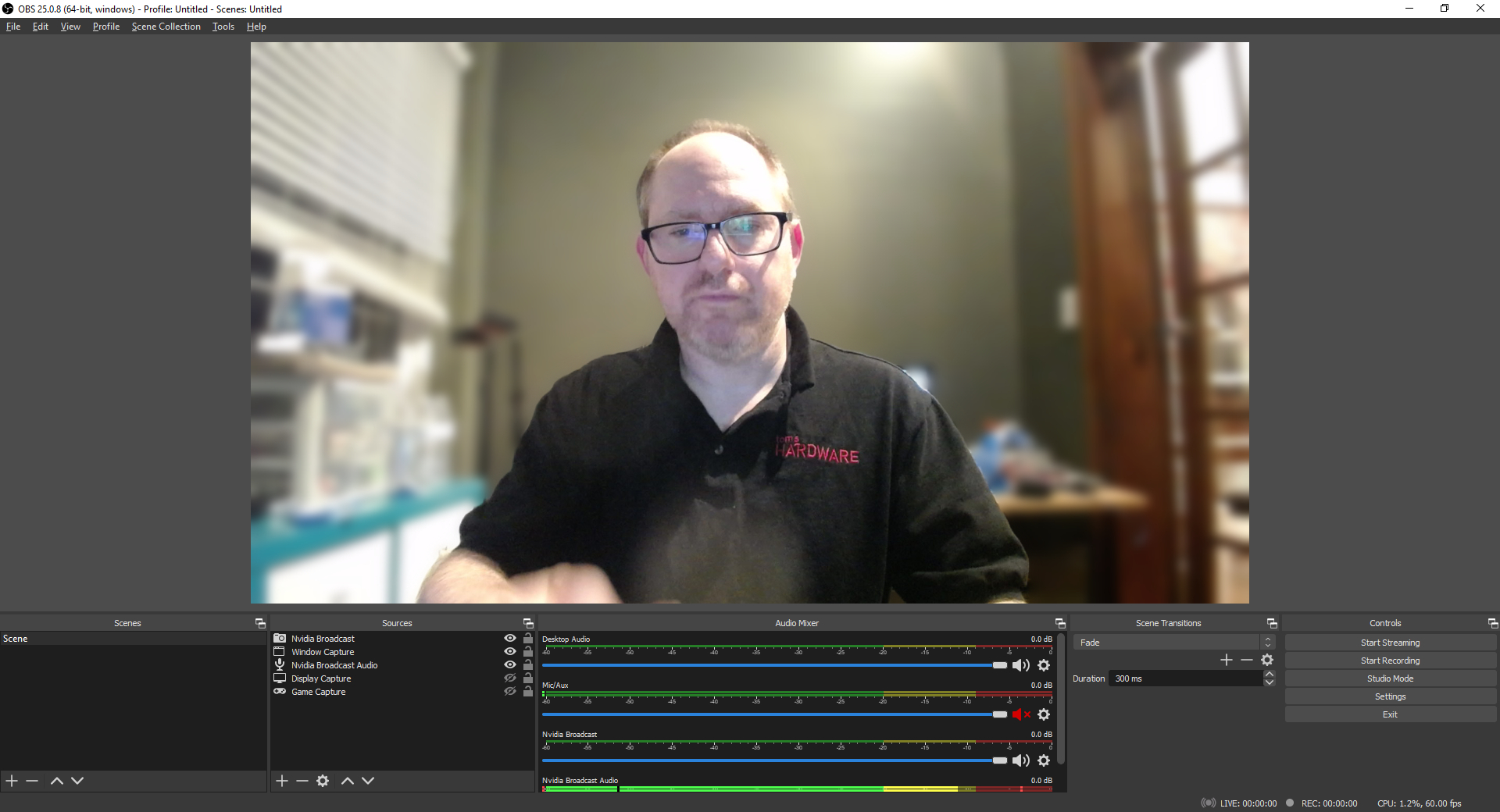
When I replaced the background behind me with a photo of a PC build, the scene looked cute, but out of proportion with my body (the computer in the photo was larger than my torso by far). And the lighting in the photo clearly didn't match my silhouetted body.

Background removal might actually be the most useful background modification option in Nvidia Broadcast, because it makes your body act like a transparent PNG or GIF that you can place on top of any other video feed. Using OBS, I put in the corner while I displayed the windows desktop across the full screen, thus making it look like I was living in the right corner of the task bar. For doing tutorials and playing games, background removal makes a lot of sense as it allows you to show more of the software you're demoing and none of the bookshelf behind you.
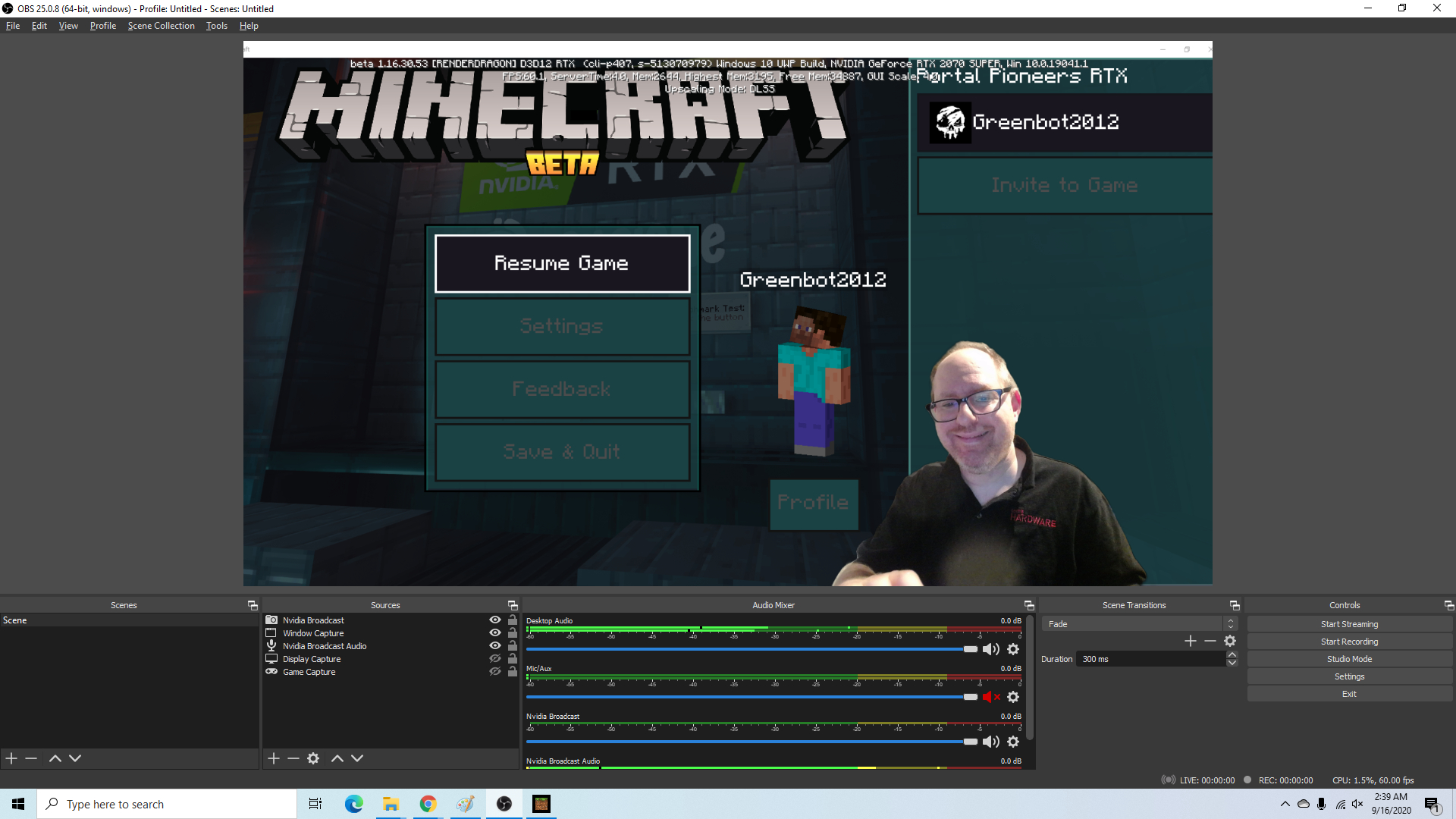
Auto Framing in Nvidia Broadcast
If, and only if, you don't want to use one of the background modification options, you can enable Auto Frame, which has the webcam appear to follow your head by cropping the image to make sure you are centered at all times. I found that Auto Frame works as advertised when I moved my head left and right and saw the image adjust accordingly. However, if I moved outside of the camera's field of view, obviously, it couldn't help me.
Auto Frame made me wish that someone would invent a pan and tilt webcam that uses servo motors to actually adjust its viewpoint. I bet there's a way to do something like that with Raspberry Pi, but it would be neat if you could buy a mass market device that did this.
Bottom Line
Nvidia Broadcast is an impressive piece of free software that will help you avoid embarrassment in meetings, podcasts and streams by accurately getting rid of unwanted background noise and cluttered backgrounds. However, nothing beats actual reality and, if you're a semi-serious streamer or podcaster, you'll want to invest in one of the best gaming microphones and try to find a quiet room during broadcasts (if it's possible). The background removal is great for tutorials and game streams, but the blurring effect (lightly applied) is probably your best bet for meetings and podcasts.
Avram Piltch is Managing Editor: Special Projects. When he's not playing with the latest gadgets at work or putting on VR helmets at trade shows, you'll find him rooting his phone, taking apart his PC, or coding plugins. With his technical knowledge and passion for testing, Avram developed many real-world benchmarks, including our laptop battery test.
-
jdlarrimo Is the app available for public release, by any chance? Or will that come at a later date for consumers?Reply -
JarredWaltonGPU Reply
I think Nvidia Broadcast will be publicly available (though still in beta) tomorrow with the official RTX 3080 launch.jdlarrimo said:Is the app available for public release, by any chance? Or will that come at a later date for consumers? -
Zeruel23 Will it also work just fine on GTX cards like RTX Voice does after simply removing a single line from the config file before the install? (The one where it specifically looks for an RTX GPU and will throw a fit if it can't find one.)Reply
I have been running RTX Voice on my GTX 1080 ever since RTX Voice was released. Works great too, I have to give them that.
Of course it doesn't have the fancy green screen effects this new features does, but even Zoom can do some of that (with varying success) withouth being tied to a specific GPU maker.
Still a <Mod Edit> move by Nvidia and before anyone gets too upset, I've been Team Green (strictly for GPU) ever since my first 8800 GT. -
Shadowclash10 This is great! RTX Voice was pretty neat, but this is the next tier. Sadly, AMD hasn't said they have anything up their sleeve like this.Reply -
JarredWaltonGPU Reply
The question is really whether Broadcast is using the tensor cores, or if it's just using CUDA cores. The latter should run just fine on GTX cards, but if it's using tensor (and actually needs the FP16 performance that brings to bear), RTX is required. Nvidia hasn't stated whether it's using tensor cores, but it does advertise the software as RTX-only.Zeruel23 said:Will it also work just fine on GTX cards like RTX Voice does after simply removing a single line from the config file before the install? (The one where it specifically looks for an RTX GPU and will throw a fit if it can't find one.)
I have been running RTX Voice on my GTX 1080 ever since RTX Voice was released. Works great too, I have to give them that.
Of course it doesn't have the fancy green screen effects this new features does, but even Zoom can do some of that (with varying success) withouth being tied to a specific GPU maker.
Still a <Mod Edit> move by Nvidia and before anyone gets too upset, I've been Team Green (strictly for GPU) ever since my first 8800 GT. -
Zeruel23 ReplyJarredWaltonGPU said:The question is really whether Broadcast is using the tensor cores, or if it's just using CUDA cores. The latter should run just fine on GTX cards, but if it's using tensor (and actually needs the FP16 performance that brings to bear), RTX is required. Nvidia hasn't stated whether it's using tensor cores, but it does advertise the software as RTX-only.
That was my (foul-mouthed) point. They did the same thing when RTX Voice was released and the install would fail on GTX cards because they were supposedly unsupported.
It turned out that the installer was actively checking for an RTX card in the system and would fail if it didn't find one.
So far so understandable, if it was really relying on the tensor cores to work its magic.
What irked me and others however was the fact, that the install completed just fine, if that check was removed from the install config and RTX Voice is fully functional on GTX cards. -
GrumpyVidiot Is there a special driver needed? I have a 2080 with the latest game ready driver installed. The broadcast install fails saying I need an R455 driver or higher............Reply -
COLGeek Reply
Here: https://www.nvidia.com/en-us/geforce/drivers/FatThorGG said:Where do you get the R455 Driver? -
FatThorGG Reply
I was looking at my current card, LOL. It's under 30 series face palmCOLGeek said:Here: https://www.nvidia.com/en-us/geforce/drivers/
